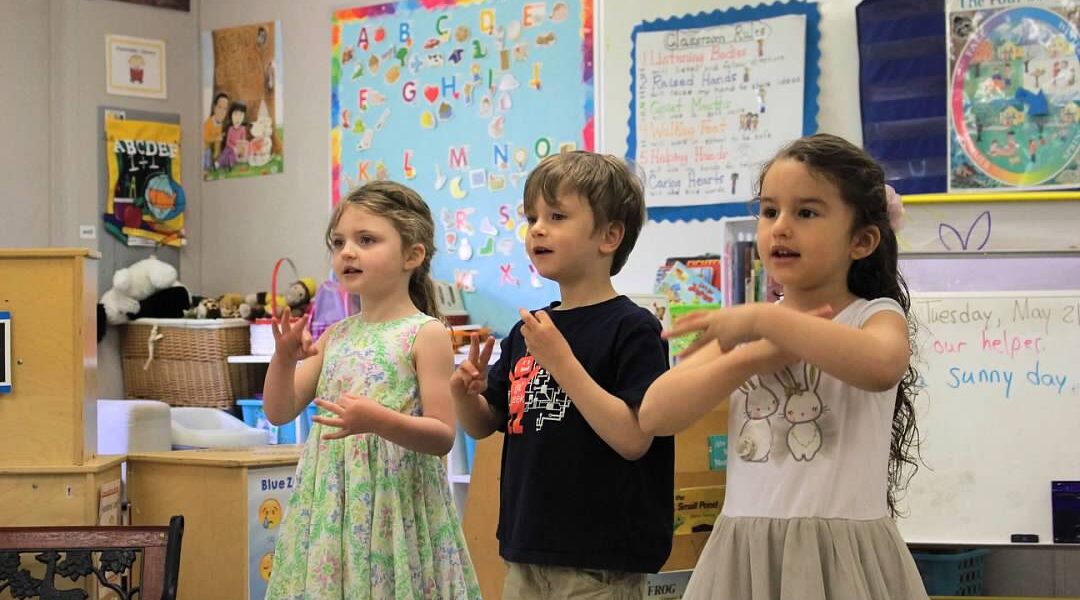
Annie Zinovenko
Head Teacher

Our Schedule
Independent, self-directed parallel and interactive play with the open-ended materials in our room.
Daily calendar, weather, alphabet, sounds, number recognition, skip counting, and story sequencing.
We practice letter and number recognition, holding crayons/pencils, tracing shapes, color matching, and other pre-reading & writing skills.
During group meal times, we practice our table manners.
We explore a trail and collect various treasures like rocks, clovers, acorns, and dirt to bring back to the classroom.
We practice our pre-math skills, like one-to-one correspondence, grouping, sets, greater than / less than, weight, volume, and estimating.
Drama, Original Play, Art, Yoga, or Spanish.
We use interesting tools and materials to build two- and three-dimensional artwork.
During group meal times, we work on our table manners.
We read fairy tales and other stories, then let the children engage in peer play.
We settle down for our 1-hour afternoon nap.
During group meal times, we practice our table manners.
Children run and play on the Easton Country Day School “big kids’ playground”.
We read calming wind-down stories and practice our clean-up jobs.
Final pick-up time is 6:00 PM. See you tomorrow!
Our Developmental Goals for the Pre-K Fours Room
By age five
MOTOR DEVELOPMENT
Fine Motor Skills
Use pencils, markers, and crayons with correct grip.
Write first name with recognizable letters (left to right).
Write numbers.
Copy shapes correctly.
Cut with scissors in straight and curved lines.
Use manipulative materials successfully (stringing beads, puzzle work, geo-boards, etc).
Use classroom materials with good control (art materials, blocks, toys).
Attempt to read a book.
Draw people with at least four recognizable body parts and objects.
Button and zip independently.
Gross Motor Skills
Navigate climbing structures adeptly.
Dance to music.
Kick a ball in intended direction.
Run at fast, slow, and in- between speeds.
Come to a running stop without falling or flopping down.
Throw and catch a ball.
Hop, jump, gallop and skip.
Balance on a beam.
SOCIAL DEVELOPMENT
Refine cooperative skills such as taking turns and sharing.
Use words to express emotions such as fear, affection, humor and
excitement in an appropriate manner.
Develop and sustain friendships.
Show persistence with a difficult task.
Engage in cooperative play and follow agreed-upon rules.
Take turns and share objects.
Transition from one activity to another easily, and resolve conflicts with peers independently.
Play well with others and respond appropriately to the materials, space and adult supervision in the room.
Follow simple requests, and take opportunities to
exhibit responsibility, helpfulness, and leadership roles.
Develop positive relationships with peers and teachers.
Anticipate others’ responses to his/her actions.
Transition between parent/teacher care comfortably.
LANGAUGE DEVELOPMENT
Adapt speech and nonverbal communication in
culturally appropriate ways (usually).
Ask many who, what, where and why questions.
Use language to organize thoughts, and link multiple ideas by sentence combining.
Tell simple stories, using sequencing to create the order of events.
Take turns in conversations without interrupting.
Talk in front of a group of peers.
Recite simple rhymes, songs, and finger plays.
Express ideas, wants and needs to adults and peers.
Speak with age-appropriate clarity.
Speak using the correct voice volume.
Begin to read facial expressions and body language.
COGNATIVE DEVELOPMENT
Identify differences, match, sort, and begin to label objects by one or more attributes (such as color, size, shape, similarities and differences).
Build an understanding of numbers and their quantity.
Count 10 objects 1-10; graph and identify greater than/less than/equal to, and create new patterns.
Make observations and predict outcomes.
Verbalize observations.
Listen to stories read aloud.
Show direction text is read.
Identify the beginning and ending of pages.
Sequence stories in the order of events taking place.
Use pictures to retell story.
Join in on repetitive phrases.
Identifies rhyming words.
Understand that spoken words can be written down.
Begins to name specific letters and the sound they make.
Print and identify first name.

